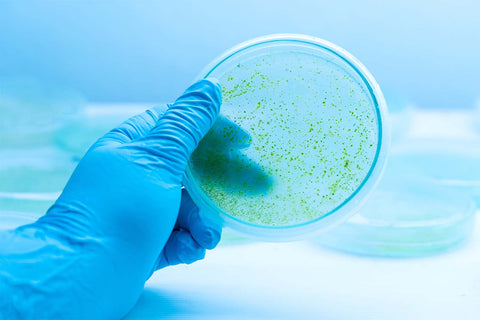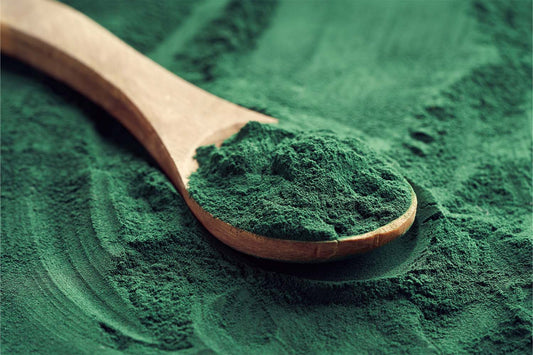If you have ever seen a green dusting on the surface water of a lake or pond, you have probably seen blue-green algal blooms, but you probably never considered whether you could eat it.
Blue-green algae have plenty of underlying secrets, from their name to their nutritional benefits. Blue-green algae are rich in a variety of nutrients, although there may be potential risks in certain circumstances. Despite the name, blue-green algae are quite different from true algae, and iwi life is here to help explain the distinctions.
What Is Blue Green Algae?
Despite its name, blue-green algae are not actually algae at all. Blue-green algae is a type of cyanobacteria found in aquatic ecosystems. Blue-green algae are commonly mistaken for plants, but they lack a nucleus and organelles. On their own, these cyanobacteria are microscopic, but when they are grouped together, they can be seen clearly in what is called a bloom.
Blue-green algae are able to bloom most easily in warm, shallow, still water. As a result, cyanobacteria are most often found along shorelines or in small bodies of water like ponds. There are several species of blue-green algae, including Aphanizomenon flos-aquae, Spirulina platensis, Spirulina maxima, Spirulina fusiformis, and Nostoc commune var. spheroids. Many of these species have been consumed by humans for centuries. For example, historians trace the consumption of Spirulina platensis back to the 14th century Aztecs. Throughout history, humans have used blue-green algae for food and medicine.
Still today, many people consume blue-green algae. These cyanobacteria contain many vitamins, minerals, and bioactive compounds that may offer several benefits. As a result, many people use blue-green algae for its nutritional composition as a human health supplement.
How Can You Distinguish Blue-Green Algae?

If you come across a body of water, like lake water, that is sporting what looks like algae, there are a few features you can look for to distinguish it from other types of life. One of the features to look for is roots or leaves. If it has these features that look like a plant, it is likely an aquatic plant, such as duckweed, and not blue-green algae.
Blue-green algae get their name from the underlying color of the algae. They contain a blue pigment called phycocyanin that allows them to capture green visible light, something other types of algae cannot capture! This makes it pretty competitive out there in the lake.
Blue-green algae also differ because they lack a nucleus and organelles as prokaryotes rather than eukaryotes. Both cyano- and “true” algae form filamentous colonies that can intertwine and clump.
Are There Benefits of Blue Green Algae?
Some blue green algae can offer multiple health benefits. These cyanobacteria can be high in protein, iron, and other nutrients. Because of this, many people use these blue-green algae as a nutritional supplement. Many take it as a supplement to increase their protein intake, but blue-green algae can also support heart health.
One way blue-green algae supports the heart is by helping maintain healthy blood pressure. The cyanobacteria also work to support healthy cholesterol by maintaining a healthy balance of fat in the blood.
Blue-green algae are full of bioactive compounds, like carotenoids, linolenic acid, phycocyanin, fibers, and plant sterols that support general health and wellness. It is also naturally rich in vitamins and minerals, including essential amino acids, B vitamins, calcium, phosphorus, and phytonutrients like chlorophyll and xanthophylls. In many ways, these cyanobacteria are richer in nutrients than many plant-based foods, providing a great nutritional option for those following a plant-based diet.
Since it is rich in many compounds and nutrients, blue-green algae offer multiple additional benefits. It can help support healthy aging by working to support cellular health. Blue-green algae can also support a healthy liver and metabolic health.
What Can Algae Supplements Be Used For?
Blue-green algae is widely available in the form of supplements, alongside other types of algae as well. Algae supplements can be a convenient way to add more nutrients into your lifestyle, especially if you follow a plant-based diet.
Here at iwi life, we use algae oil made from the green algae Nannochloropsis as a plant-based source of EPA and DHA to support overall health and wellness.
What Are the Different Types of Blue-Green and Green Algae?

As mentioned earlier, many types of blue-green algae have been used for different purposes throughout history. Each type of blue-green algae may offer its own benefits, as they are each composed of different nutrients and used in different products.
Spirulina
Spirulina is a common ingredient on the label of many health foods and supplements and is considered one of the most nutrient-dense foods on the planet. This form of blue-green algae is high in nutrients like ALA omega-3 and omega-6 fatty acids, protein, copper, iron, and B vitamins. Unlike other cyanobacteria, spirulina does not contain B12, but it has a higher protein content than all other forms. That said, a single daily serving only contains 2 grams of protein, so it is not a robust source.
Chlorella
Chlorella is found in freshwater andpresents less risk for toxins than other types of blue-green algae. This form of green algae has larger amounts of vitamins B12 and D2 than other forms. Chlorella also contains large amounts of folate and iron. In addition to potential benefits for healthy blood pressure and cholesterol levels, studies found that chlorella may support healthy immune function, especially in individuals who engage in intense physical activity.
How Does Blue-Green Algae Differ From True Algae?
Algae gave rise to what became terrestrial plants, but they are distantly related rather than sharing the same taxonomic home.
From a nutritional standpoint, true algae and cyanobacteria differ as well. True algae do not offer the same risks as blue-green algae since it produces no toxins. Algae is a vital plant to most ecosystems, providing nutrition to various types of fish and animals. Not all blue-green algae are bad, and some cyanobacteria are part of the diverse “phytoplankton” group that is the base of aquatic food webs. However, cyanobacteria do not produce EPA and DHA, so you will still need an omega-3 source to compliment any blue-green algae.
Two key nutrients not produced by spirulina or chlorella are docosahexaenoic acid (DHA) and eicosapentaenoic acid (EPA). DHA and EPA are two vital omega-3 fatty acids that make up the foundation of many cells in the body; however, they are not produced in large amounts by the body, making supplementation important. Algae is a rich source of both DHA and EPA omega-3s.
Both DHA and EPA have multiple benefits. DHA supports eye health, cognitive function, and healthy brain development during pregnancy and childhood. EPA plays a role in supporting a healthy mood and maintaining bodily functions like blood pressure. Both nutrients also play a role in supporting overall heart health.
The most commonly recognized source of DHA and EPA is fatty fish. Many supplement shoppers are surprised to learn that fish obtain their omega-3 fatty acids from consuming large amounts of algae, meaning that one of the best ways to obtain these fatty acids yourself is to receive them directly from the source.
At iwi life, we create our supplements using a sustainably sourced microalgal species called nannochloropsis, which is rich in both EPA and DHA. This algae also provides more bioavailable omega-3 fatty acids than fish, as the nutrients can be absorbed at a rate at least 1.7X better than sources like krill or fish oil.
Discover the Benefits of Nannochloropsis Algae
At iwi life, our algae are specially farmed in salty desert ponds, meaning that it is always free of harmful contaminants. We combine all the amazing benefits of true algae into our family of supplements.
Our omega-3 supplement uses the power of microalgae to provide your body with vital nutrients, including EPA and DHA fatty acids. The supplement is also complete with omega-6, omega-7, and omega-9 fatty acids to promote even more benefits, while polar lipids ensure maximum absorption. This plant-based form of omega-3 allows you to leave fish oil and its unpleasant “fish burps” in the past. Try our omega-3 supplement for yourself and experience all it has to offer.
Sources:
How to identify blue-green algae and what to do about it | Grace College















